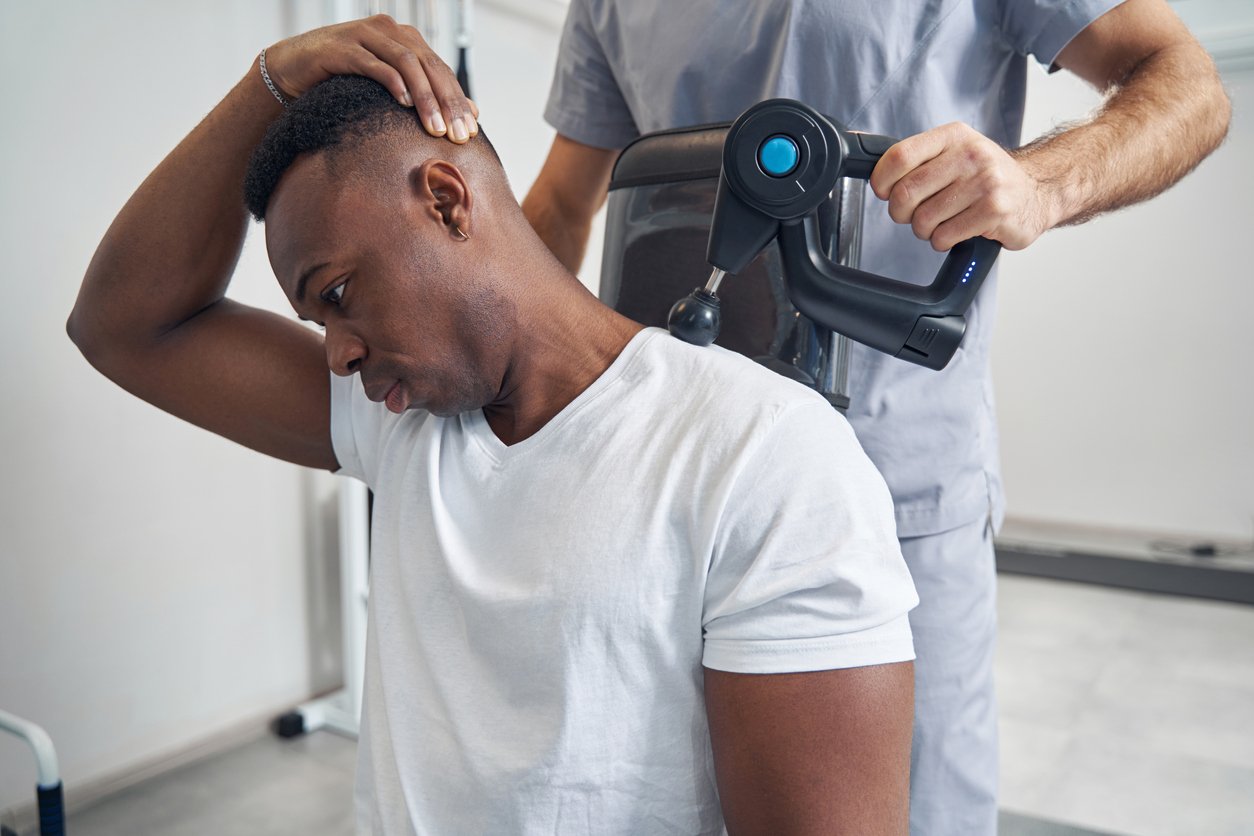Physical Therapy
Dr. Han works with you to develop a physical therapy program that is clear and effective so you understand why you’re doing each exercise and how it benefits you. This makes it easier to continue your exercises at home between sessions or maintain your strength and flexibility after you’ve completed your treatment plan.
When you arrive for your session, Dr. Han recommends wearing comfortable clothing that you can exercise in and bringing water and a towel, if desired. Each session is completed one on one with Dr. Han so you can get the attention you need and have all of your questions answered.
Dr. Han begins each session with a warm up and passive therapies, like heat, to include blood flow and prepare your muscles for exercise. He then onto the exercise portion of the session, which may include bodyweight exercise, resistance bands, or free weights. Once you’ve completed your exercise, Dr. Han ends the session with a cool down and stretching.
During your initial consultation and exam, Dr. Han performs a series of orthopedic tests and asks questions about your symptoms in order to determine your diagnosis. Based on your diagnosis, he recommends a treatment plan, which can include physical therapy.
Dr. Han typically recommends a series of physical therapy sessions two to three times per week when you’re first starting out. As your condition improves, he decreases the frequency of your visits until you’ve recovered fully. Dr. Han also explains at home-exercises and stretches you can do to maintain your progress between visits.
Physical Therapy is a treatment option for many causes of pain and injuries. Research has shown that physical Therapy can help:
Increase flexibility
Improve blood flow
Increase physical strength
Improve stability and balance
Relieve pain
Prevent Injury
Dr. Han offers a variety of physical therapy modalities to address pain and injuries so you can recover and get back to your favorite activities. Some physical therapy options include:
Manual Therapy
Functional movement screens
Cold laser Therapy
Instrument assisted soft tissue mobilization (IASTM)
Kinesiology Taping
Self Myofascial Release
Postural rehab
Exercises and stretches
Functional Movement Screen
If you struggle with certain movements at the gym or when playing sports or have experienced an injury, a functional movement screen from Daniel Han, DC can help pinpoint the cause. At Nabi Movement in Edgewater, New Jersey, Dr. Han uses functional movement screens to identify areas of muscle weakness or tightness. A screening is the first step to recovering from injury, but can also help you get stronger or more flexible to prevent pain. Find out how a functional movement screen can benefit you by calling Nabi Movement or scheduling online today.
A Functional movement screen (FMS) is a medical movement test that assesses seven different movement patterns identify areas of muscle imbalance, like tightness, weakness, or injury.
The seven movement patterns are:
Deep Squat
Hurdles step
Incline lunge
Shoulder mobility
Active straight leg raise
Trunk stability push up
Rotary stability
Depending on your symptoms, Dr. Han can perform some or all of the movement screenings to identify areas of concert that require treatment or rehab. A FMS - also called a selective functional movement assessment (SFMA)- can also be performed on healthy people without any symptoms. In this case, it can help you understand how your body moves and ways you can prevent pain or injury.
The purpose of FMS is to identify areas of muscle imbalance, and this, in turn, helps Dr. Han develop a treatment plan to address your specific concerns or areas of pain. Based on his findings during your FMS, Dr. Han builds a treatment plan incorporating chiropractic care, manual therapy, and postural rehab to improve your flexibility, strength, and stability.
Dra. Han then shows you which muscles need to be stretched or strengthened and specific exercises you can do to improve your joint mobility. These exercises also serve to improve the function of your joints and muscles, and this can help you heal after an injury and prevent future pain.
While you don’t need to do anything to prepare for your FMS, it’s a good idea to wear comfortable exercise clothing that you can move in, Dr. Han provides all of the equipment you need to perform the movements, like a bar you hold overhead during your deep squats.
Some patients find that FMS can be tiring, especially since you have to repeat the exercises while Dr. Han views each movement from different angles. IF you feel tired or uncomfortable at any point, let Dr. Han know and he can modify the movements to make it easier for you if appropriate.
After your FMS, Dr. Han reviews his findings with you and provides recommendations based on your results.
Sports Medicine
At some point while working out or playing sports, most people experience sore muscles or bruising that doesn’t require medical attention. However, some types of injuries require medical care like:
Sprains
Strains
Knee Injuries, like meniscus tears
Tendonitis
Rotator cuff injuries
Golfer’s or Tennis elbow
Iliotibial (IT) band syndrome
Jumper’s knee
Plantar Fasciitis
It’s best to see Dr. Han as soon as possible after experiencing a sports injury so that you can get a diagnosis and treatment right away. In many cases, the sooner you get treatment for a sports injury, the sooner you’ll recover.
Common signs of sports injuries that require medical care include:
Moderate to severe bruising and swelling
Muscle or joint pain
Decreased range of motion
Difficulty bearing weight on the affected leg or foot
Trouble moving an injured shoulder, elbow, or wrist
Pain with specific movements
More serious sports injuries like fractures and dislocations require emergency care. If Dr. Han suspects you have a more serious injury, he provides referrals to the appropriate medical professionals so you can get the treatment you need
To diagnose a sports injury, Dr. Han begins by asking about your symptoms and the cause of your injury, Then he performs a thorough orthopedic exam to check your range of motion, muscle strength, and nerve function Dr Han also performs tests to check the structural integrity of your joints and muscles.
In some cases, Dr. Han may refer you for X-Rays or an MRI if he suspects a more serious injury or you’re not healing normally
For most sports injuries, Dr. Han recommends using ice on the injured area and resting. He provides a variety of treatments to speed up your healing, including chiropractic care, physical therapy, and manual therapy.
The First goal of treatment is to relieve your pain, So Dr. Han uses different techniques to address your discomfort, like cold laser therapy, kinesiology taping, hyper-volt, air relax, foam rolling or lacrosse ball rolling, and chiropractic care. Once your pain level has decreased, the second step is to support the repair of the injured tissues through manual and physical therapies, which can also prevent re-injury in the future.
Postural Rehabilitation
Postural Rehabilitation involves a postural assessment and rehabilitative exercises and stretches to correct muscle imbalances that lead to poor posture. Dr. Han works with patients of all ages to improve their posture, which can relieve pain when standing, walking, or sitting.
Proper posture involves the coordination of the flexor muscles on the front of your body and the extensor muscles on the back of our body. Due to desk work, repetitive movements, and injuries, the coordination of these muscles can be lost over time, resulting in poor posture.
A postural assessment is a visual exam of your body while you’re sitting and standing. Dr. Han completes a thorough postural assessment by having you stand or sit still for a few minutes while he views your posture from the front, back and sides of your body.
Dr. Han assess your posture to look for:
The alignment of your head and neck
Uneven shoulder heights
Rounding or arching of your spine
Tilting of your head, shoulders, or pelvis
One hip higher than the other
Alignment of your knees
Toes pointing inward, straight ahead, or outward
Dr. Han can combine a postural assessment with a functional movement screen if he suspects more complex muscular imbalances are contributing to any pain or injuries you’re experiencing.
Proper posture is important because it allows your body to be still and move comfortably without tension, pain or stiffness in your muscles or joints. Strong, flexible muscles associated with proper posture can help prevent:
Neck pain
Headaches
Back pain
Shoulder injuries
Knee injuries
Jaw pain
Foot and ankle pain
Posture is also important when you’re working, whether you’re on your feet all day or sit at a desk. Dr. Han can also assess your posture during daily activities, like computer work, looking at your cell phone, or performing repetitive movements for your job, to gain insight into your pain or injury.
In order to develop better posture, Dr. Han teaches you stretches and exercises you can perform at the gym, home, or work. He chooses exercises and stretches specific for your body and postural issues. Most postural stretches and exercises can be performed in just a few minutes per day to get results.











